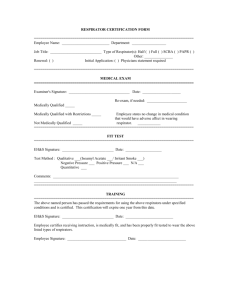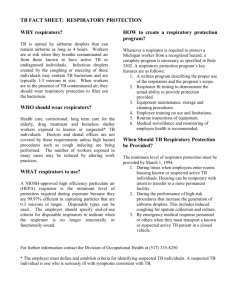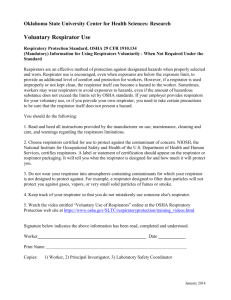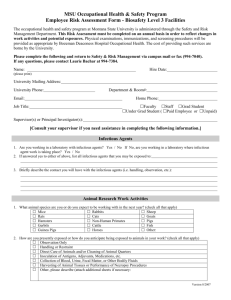Respiratory protection Document N° 6.1 TB Infection Control
advertisement
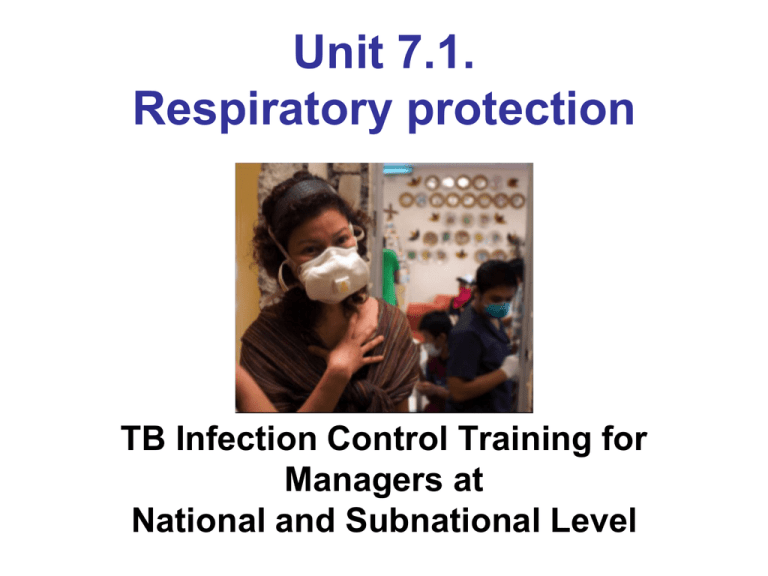
Unit 7.1. Respiratory protection TB Infection Control Training for Managers at National and Subnational Level Objectives After this unit, participants will be able: • To describe the differences between a surgical mask and a respirator • To name the types of respirators that protect against TB transmission, and when to use them • To list the elements of a respiratory programme 2 Outline • • • • WHO recommendations Surgical mask vs. particulate respirator Respirator standards Respirator programme – – Proper use Fit testing 3 WHO recommendations • When used with administrative and environmental controls, particulate respirators may provide health care workers (HCW) additional protection from TB Respirators • – – – Must meet or exceed standards Be properly used Be part of a training programme 4 WHO recommends particulate respirators for HCWs: • Caring for patients with confirmed or suspected infectious TB (in particular MDR-TB) Performing aerosol-generating procedures on infectious TB patients • – – Bronchoscopy, intubation, sputum induction Use of high speed devices for lung surgery or autopsy 5 Surgical masks • Reduce the spread of microorganisms from the wearer to others, by capturing large wet particles • Do not protect the wearer from inhaling small infectious aerosols. 6 Particulate respirators • Protect the wearer from inhaling droplet nuclei • Filter out infectious aerosols • Fit closely to the face to prevent leakage around the edges 7 Proper wearing of respirators (N95s and FFP2s) in Santa Cruz, Bolivia 8 Surgical masks (yes for patients) 9 Surgical masks do not protect staff from TB 10 Particulate respirators used for TB exposure N95 (USA) FFP2, FFP3 (Europe) Filter out > 95% of particles Filter out > 94-98% of particles 11 USA standards* Filter efficiency N (not resistant TB to oil) protection 95% 99% 99.97% N95 N99 N100 ✓ ✓ ✓ *National Institute for Occupational Safety and Health (NIOSH), Centers for Disease Control and Prevention (CDC) 12 European standards* Total inward leakage Filtering TB Face Piece protection <25% FFP1 Not adequate <11% FFP2 ✓ <5% FFP3 ✓ *Comité Européen de Normalisation (CEN) (European Committee for Standardization) 13 CEN standards • Total inward leakage • Initial filter penetration NaCL <20%=P1 < 6%=P2 < 3%=P3 Paraffin oil NA=P1 <2%=P2 <1%=P3 • Maximum breathing resistance • Loading test 14 Air-purifying respirators Remove specific air contaminants by passing ambient air through the airpurifying filter, cartridge or canister 15 Negative pressure respirators • air pressure inside the facepiece is negative during inhalation • contaminated air can avoid the higherresistance filter and leak in through gaps in the face seal 16 Types of air purifying respirators Non–powered (negative pressure) Powered air-purifying respirators (PAPR) • A blower draws air through the filter and blows it into the face piece • Pressure inside face piece reduces face-seal leakage (offers more protection) • Loose fitting PAPRs can be used for people that cannot achieve an adequate seal 17 Respirator programme elements • • • • • • • • Person assigned responsibility Written procedures Medical evaluation Training Selection of respirators Fit testing Maintenance Programme evaluation 18 Why is fit testing necessary? • Ensure a proper seal between respirator and wearer • Determine appropriate make/model • Determine appropriate size 19 When should fit testing be done? Employees should pass a fit test: • Prior to initial use • Whenever a different respirator facepiece (size, type, model or make) is used • Periodically thereafter • Whenever changes in the worker’s physical condition or job description that could affect respirator fit are noticed or reported 20 Sources of facepiece leakage • Around facepiece/skin interface • Through air-purifying element • Through exhalation valve 21 Factors contributing to poor fit • • • • • • • • Weight loss or gain Facial scarring Changes in dental configuration (dentures) Facial hair Cosmetic surgery Excessive makeup Mood of workers (smiling/ frowning) Body movements 22 Qualitative fit tests: • Rely on the individual’s response to the test agent to assess the adequacy of respirator fit • Are scored as pass/fail 23 Test solutions for qualitative fit testing Four methods recognized and accepted • • • • Isoamyl acetate Irritant aerosol Saccharin BitrexTM (Denatonium benzoate) 24 Fit tests using saccharin or BitrexTM • Can be used for all respirators (i.e. 95-, 99- and 100- series and FFP2 and FFP3) • Uses subject’s sense of taste • Requires the use of small test hood 25 Saccharin and BitrexTM • Subject demonstrates ability to detect weak solution in the test hood • Subject dons respirator • Strong solution (~100 times) sprayed into hood • Respirator passes if subject does not taste aerosol • Assumed fit factor = 100 26 Qualitative fit test equipment 27 Quantitative fit tests: • Measure the amount of leakage into the respirator to assess the adequacy of respirator fit • Are scored with a number 28 Maintenance and storage • Take care of your disposable respirator – Decontamination NO! – Cleaning NO! – Storage Clean & dry place! • Take care when re-using respirator – closely monitor service life • Inspect prior to each use • Dispose of the respirator if you question its performance 29 Read the manufacturer’s instructions to don the respirator properly 30 Is this respirator put on properly? 31 Post warning sign 32 Time to clear the air between patients 33 Bronchoschopy room 34 DOT room 35 Isolation XDR-TB tent and DOT 36 Summary • Surgical masks prevent infectious particles from being expelled by the wearer • Respirators protect the health care worker from inhaling infectious particles • When used with administrative and environmental controls, N95, FFP2 or FFP3 respirators provide additional protection when HCWs care for infectious TB patients • Whenever respirators are used, a respirator programme is necessary 37
